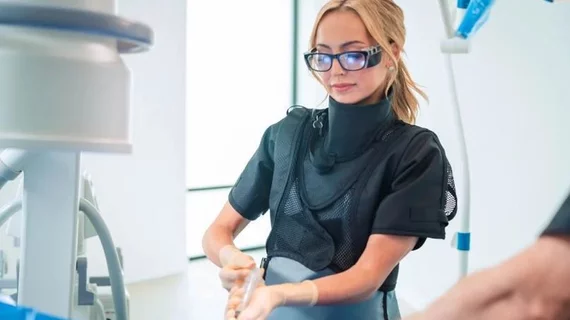Doc develops lead garment that drastically reduces radiation exposure to vulnerable areas
A new radiation protection garment said to significantly reduce exposure to areas of the body traditional lead aprons can leave vulnerable.
The BAT was designed to offer additional protection to providers, specifically female physicians, who are frequently exposed to ionizing radiation during surgery or interventional procedures. BAT is the brainchild of breast surgical oncologist Lauren Ramsey, MD.
Ramsey developed the garment after a colleague died from breast cancer. After losing her friend, who was frequently exposed to radiation during her practice, and then also learning about heightened risk of breast cancer among female orthopedic surgeons, Ramsey began to delve deeper into cancer rates in healthcare workers who routinely work in settings where radiation exposure is common.
“Female orthopedic surgeons have up to a three times higher rate of breast cancer,” Ramsey said in a statement marking the product’s rollout. “Women now make up 55% of medical school attendees and this product was developed with women in mind.”
The lightweight garment can be worn in addition to any standard lead apron without the need for specialized attachments. It offers extended coverage to the breast, axilla and thyroid. It is said to reduce exposure of these vulnerable areas by nearly 98%.
BAT is manufactured in the United States and is distributed through Burlington Medical. It contains breathable mesh panels to maintain a comfortable temperature and can be worn by both men and women. The garment is also said to provide additional protection from scatter radiation affecting the chest, neck and spine. Currently, the product retails for $500—less than the $700 it costs to buy a thyroid shield and two additional lead sleeves.
"After losing my friend, an orthopedic surgeon, to breast cancer, I wanted to find a way to better protect healthcare workers from radiation and reduce cancer risk. Standard aprons often leave gaps for radiation exposure, especially to the breast and axilla,” Ramsey said in a statement to Health Imaging. “BAT is universally compatible with any apron and can give providers peace of mind that they are being protected. With more women in the medical field, protection of the breast with BAT should be the standard.”
The National Institutes of Health estimates that up to 50% of the more than 2 million healthcare workers in the United States are exposed to ionizing radiation annually.
Learn more about the product here.

